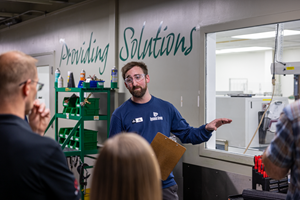Lower Prices for Five Volume Commodity Resins
Global demand slowdown and in some cases oversupply are ending the year with a buyers’ market.
Now in mid-fourth quarter, it appears that there’s a consensus that a buyers market best characterizes at the very least the five volume commodity resin markets, with a downslide in pricing for nearly all.
Here’s a recent takeaway at how our industry colleagues with pricing expertise view things for each of the five major commodity volume resins. They include purchasing consultants from Resin Technology, Inc. (RTi), Fort Worth, Texas; senior editors from Houston-based PetroChemWire; and CEO Michael Greenberg of the Plastics Exchange in Chicago.
PE: Prices are expected to drop by end of this month—essentially nixing the 3¢/lb price hike that was implemented by suppliers in September, according to Mike Burns, RTi, v.p. of PE markets; PCW’s senior editor David Barry; and The Plastic Exchange’s Greenberg. Moreover, they ventured that a further drop would take place this month, possibly on the order of 3¢/lb.
These sources see this as a buyers market, which ought to be helpful to processors in 2020 contract negotiations in terms of price concessions. They base this on weak global market demand along with the impact of trade war issues and major new supply. According to Barry, under this “new normal”—with all the new PE capacity—suppliers have been quickly moving out material. “There is more sustained high-volume export activity from North America than ever before to areas such as Southeast Asia, Europe and Africa; a trend that will need to continue as domestic demand for 2019 is likely to end in negative growth,” Barry notes. Greenberg noted that spot PE prices were lower with domestic demand lacking luster.
PP: Prices followed October monomer contracts in October, which settled down 1.5¢/lb to 37.5¢/lb. However, both PCW’s Barry and Scott Newell, RTi’s v.p. of PP markets, report that additional non-monomer price decreases on the order of 2-3¢/lb and as much as 5¢/lb were being negotiated by some buyers between October and this month. In his last report, The Plastic Exchange’s Greenberg reported, “Weaker feedstock costs are pointing to lower November PP resin contracts and suppliers got ahead of the game by offering cheaper spot PP prices, down about 2 cents, which spurred better buying.”
According to Newell, demand for PP has been disappointing all year, with supplier inventory days into October at an all-time high of 39-40 days, and ventured that processors’ inventories are also high as they felt the “headwinds of low demand” at the start of the second half of this year.
PS: Prices were heading downward this month, following flat pricing in October, as benzene prices dropped as did demand, according to both PCW’s Barry and Robin Chesshier, RTi’s v.p. of PE, PS and nylon 6 markets. They venture that November PS prices could drop 2-3¢/lb, with the potential for another 2¢/lb decline this month.
Barry reported that November spot PS prices are already down 3¢/lb, driven by lower benzene costs and demand that was slow even by seasonal standards.
PVC: Prices this month are likely to be flat-to-down by 1¢/lb, according to both Mark Kallman, RTi’s v.p. of PVC and engineering resins and PCW senior editor Donna Todd. This after a rollover in October, despite suppliers’ 3¢/lb increase for that month. Suppliers attribute their price move to ethylene prices which rose a total of 6.25¢/lb between July through the recent October settlement.
However, both sources note that PVC prices did not drop in the spring when ethylene prices dropped by 10.25¢/lb. “They can’t have it both ways,” says Kallman. Moreover, ethylene prices are projected to be flat this month and move down in December. Kallman projects that 2020 will be another challenging year for PVC, noting that total demand domestic/exports through third quarter was down by 3% (with domestic down 4%, and exports down 1%).
PET: Prices ended October as a rollover in the 47-51¢/lb range. By early November, however, domestic PET resin buyers were bidding at the low-to-mid 40¢/lb range for pickup on the West Coast; selling interest by distributors was firm at the high 40s-low-50¢/lb range, according to PCW senior editor Xavier Cronin. He anticipated this month to remain a buyers’ market for PET resin; penciled-down resin (normal-spec resin priced lower to liquidate surplus inventory); and offgrade PET due to bloated supply. He also ventures there’s potential for a 2-5¢/lb decline next month driven by oversupply and the holiday demand slowdown period. He notes that there is plenty of resin available from domestic producers and their distributors with plenty of imports from around the world available throughout the country—from the Eastern Seaboard to the Gulf Coast, Great Lakes locations, the Pacific Northeast and the Golden State.
Related Content
How to Extrusion Blow Mold PHA/PLA Blends
You need to pay attention to the inherent characteristics of biopolymers PHA/PLA materials when setting process parameters to realize better and more consistent outcomes.
Read MoreWisconsin Firms Unite in Battle Against Covid
Teel Plastics opened new plant in record time, partnering with AEC & Aqua Poly Equipment Co. to expand production of swab sticks to fight pandemic.
Read More‘Monomaterial’ Trend in Packaging and Beyond Will Only Thrive
In terms of sustainability measures, monomaterial structures are already making good headway and will evolve even further.
Read MoreMedical Molder, Moldmaker Embraces Continuous Improvement
True to the adjective in its name, Dynamic Group has been characterized by constant change, activity and progress over its nearly five decades as a medical molder and moldmaker.
Read MoreRead Next
Making the Circular Economy a Reality
Driven by brand owner demands and new worldwide legislation, the entire supply chain is working toward the shift to circularity, with some evidence the circular economy has already begun.
Read MoreBeyond Prototypes: 8 Ways the Plastics Industry Is Using 3D Printing
Plastics processors are finding applications for 3D printing around the plant and across the supply chain. Here are 8 examples to look for at NPE 2024.
Read More













 (2).jpg;maxWidth=300;quality=90)










